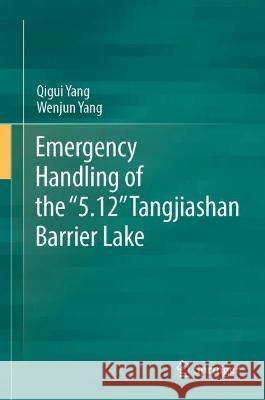Emergency Handling of the "5.12" Tangjiashan Barrier Lake » książka



Emergency Handling of the "5.12" Tangjiashan Barrier Lake
ISBN-13: 9789819917051 / Angielski
Emergency Handling of the "5.12" Tangjiashan Barrier Lake
ISBN-13: 9789819917051 / Angielski
(netto: 576,41 VAT: 5%)
Najniższa cena z 30 dni: 578,30
ok. 22 dni roboczych.
Darmowa dostawa!
Introduction.- Hydrologic analysis of Tangjiashan barrier lake area.- Geological characteristics of Tangjiashan barrier lake area.- Outburst flood evolution analysis of Tangjiashan barrier lake.- Study on the anti-impact stability of discontinuous wide graded mixture of weir body.- Study on the emergency danger elimination plan of Tangjiashan barrier lake.- Construction of Tangjiashan barrier lake emergency danger elimination project.- Emergency monitoring and assurance system.- Evaluation of the discharge process of lake water and the effect of risk removal.
Qigui Yang is “National Engineering Survey and Design Master”, professorate senior engineer, doctoral supervisor, currently is chairman of the board of CISPDR Corporation, “Young and Middle-aged Expert with Outstanding
National Contributions”, and the winner of the First National Innovation Competition Award. He has long been engaged in the design of embankment dam and geotechnical engineering, risk assessment and research of emergency rescue technology of barrier lake. He proposed risk assessment methods of barrier lake and built a
technical system of emergency response, which fills the gap in barrier lake emergency response technology at home and abroad. He is responsible for or participate in more than 30 national research projects and engineering research projects. He successfully removed the risk of the Tangjiashan barrier lake, which was praised by the General Command of the State Council for earthquake relief as "a miracle of handling large barrier lakes in the world". He has been crowned the National Award for Science and Technology twice (ranked
1st and 2nd), honored with 2 Provincial and Ministerial Science and Technology Progress Special Awards (all ranked 1st), 5 first Awards;1 National Excellent Engineering Survey and Design Gold Award, 2 Silver Award. He is the holder of 25 Chinese Invention patents (12 items ranked 1st), 14 International Invention patents (6 items ranked 1st), and wrote 7 technical standards (2 items ranked 1st). He is also the author/coauthor of more than 80 research papers, and the first author of 5 books.
Wenjun Yang is a professorate senior engineer and doctoral supervisor. He is currently
the vice president of the Changjiang River Scientific Research Institute and an
expert enjoying special government subsidies from the State Council. He is
national level candidate for the "The New Century Talents Project"
and the first ministerial level candidate for the "5151 Talents
Project" of the Ministry of Water Resources. He won the Outstanding Youth
Award of the Chinese Hydraulic Engineering Society and the First Zhang Guangdou
Outstanding Youth Award. He has been long engaged in technical research on
hydraulics and river dynamics, water environment and ecological water
conservancy, and water and sediment measurement technology. He presided 2
scientific and technological support projects during the 11th Five-Year Plan,
and was responsible for one National Key Research and Development Project
during the 13th Five-Year Plan, three science and technology projects such as
major scientific research instrument development projects and general program
of the National Natural Science Foundation of China. He has been crowned the
National Science and Technology Progress Award three times, and awarded the
National Engineering Design Gold Prize, 7 Provincial and Ministerial Science
and Technology Progress First and Special Prizes. He is the first author of 4
books, the co-author of 3 technical standards. He is also the holder of more
than 20 invention patents, and the author/coauthor of more than 100 research
papers.
This book introduces emergency management of barrier lakes systematically,
including theories and practices, risk assessment under extremely high-risk
conditions, evolution of outburst floods, analysis of anti-impact stability, and
emergency management technology and assessment of risk elimination effect.
It takes the Tangjiashan barrier lake as a successful case study to
illustrate effective treatment of barrier lake with high risks, poor environmental
conditions, extremely urgent rescue time and high disposal difficulties. It
retains a large number of images and data of great research value for the lake
risk assessment and building technological emergency system. It provides a
reliable reference for the government, scientific researchers and survey and
design team to deal with the sudden natural disaster in barrier lakes,
especially caused by huge earthquake.
1997-2026 DolnySlask.com Agencja Internetowa
KrainaKsiazek.PL - Księgarnia Internetowa









